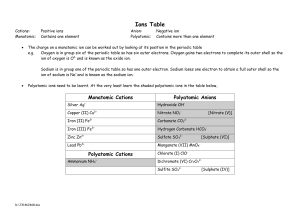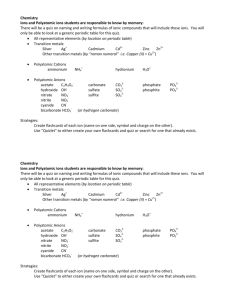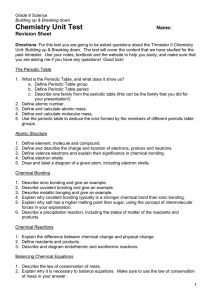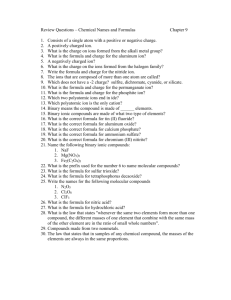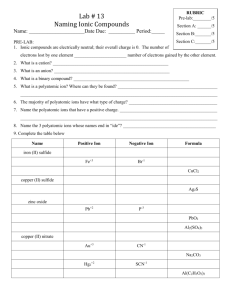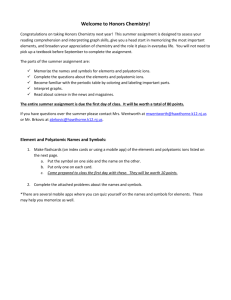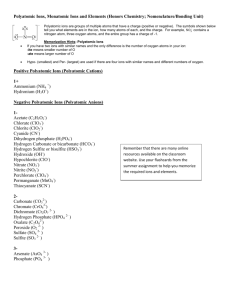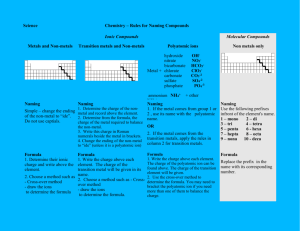Physical Science- sci 10 review notes
advertisement
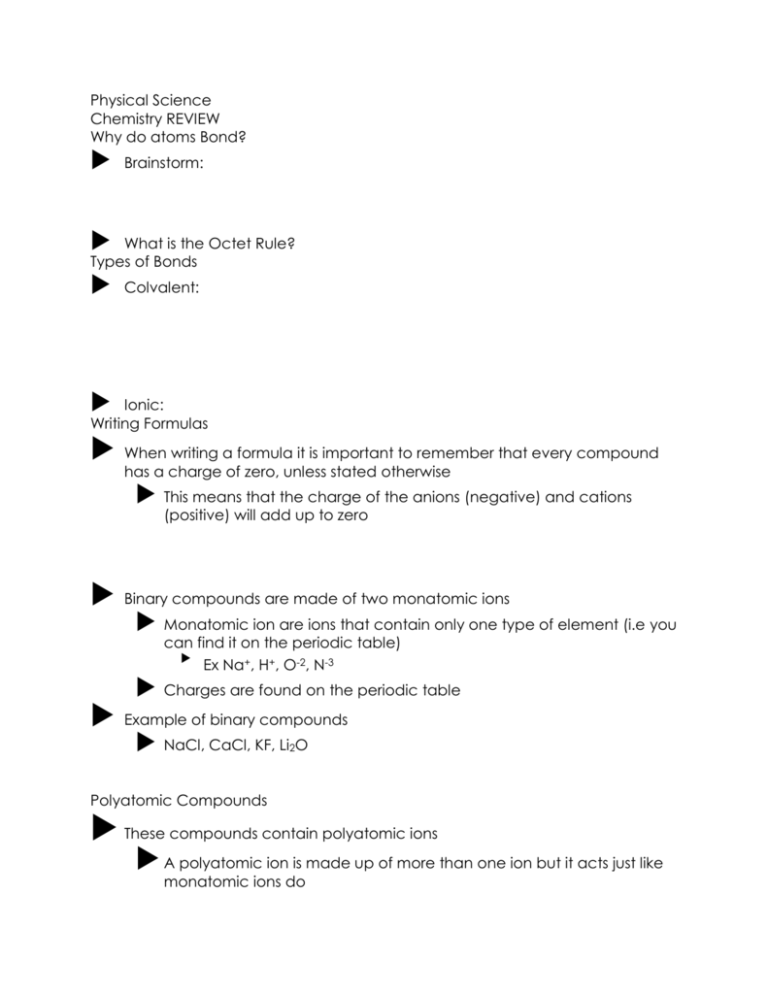
Physical Science Chemistry REVIEW Why do atoms Bond? Brainstorm: What is the Octet Rule? Types of Bonds Colvalent: Ionic: Writing Formulas When writing a formula it is important to remember that every compound has a charge of zero, unless stated otherwise This means that the charge of the anions (negative) and cations (positive) will add up to zero Binary compounds are made of two monatomic ions Monatomic ion are ions that contain only one type of element (i.e you can find it on the periodic table) Ex Na+, H+, O-2, N-3 Charges are found on the periodic table Example of binary compounds NaCl, CaCl, KF, Li2O Polyatomic Compounds These compounds contain polyatomic ions A polyatomic ion is made up of more than one ion but it acts just like monatomic ions do Charges and names of polyatomic ions can be found on the back of your periodic tables **note** polyatomic ions are ALWAYS anions (negative) Examples: NO3- CO3SO4- Writing Formulas Find how many of each ion that you need to make the overall charge equal zero Hint: use the charges to determine how many atoms you need Na+1 C-4 Ca+2 C-4 Ca+1 K Na (PO4)-3 O (PO4) Naming rules Covalent naming: • • • Always write the least electronegative element first The more electronegative element is then written, but to it the suffix – ide is added to it Ex oxygen- oxide fluorine- fluoride nitrogen- nitride We now find the problem of distinguishing between compounds with more than one formula (ex CO, CO2) You Try NF3 To prevent this from occurring we add a greek prefix to the element names N2O4 OF2 Ionic Bonds Rules • Separate the compound into cations and anions • Cations- the name will stay the same Ex. Ca+2 stays as calcium Anions- the suffix –ide is added to the element name Ex. Br – becomes bromide Ion To name the ionic compound add the names of the ions together Ex. CaBr2 calcium + bromide = calcium bromide Examples: K O 2 CaF2 BaO Polyvalent metals • Some metals can have more than one charge therefore we have to distinguish which charge the metal has FeO- looking at the periodic table Fe could have a +2 or a +3 charge Ex. FeO has one anion with a -2 charge, therefore the Fe must balance that charge and have a +2 charge (the total anion and the total cation charges must be equal) To find it’s charge, look at the charge on the anion (and the number of these charges) • Now that the charge on Fe is known as +2, we have to show that in it’s name We do this by adding a roman numeral to the cation FeO- Fe has a +2 charge therefore the roman numeral II is added after iron FeO- iron (II) oxide Note only metals with more than one charge have to have the roman numeral added to it Ex. Gallium (Ga) only has one charge; which is +3, therefore we don’t have to add the roman numeral to it’s name Use the periodic table to determine which metals can have more than one charge In pairs look at the periodic table and list those metals that can have more than one charge Balancing Equations • • • • Write down the unbalanced equation Draw boxes around each chemical formula- never ever change anything inside the boxes Make an element inventory- write down how many of each element you have Write numbers in front of the boxes to try to get the same number of atoms on each side of the equation Some of Mrs. Lalonde`s Helpful Hints for balancing equations Save H for next to last, and O until last. IF everything balances except for O, double all the coefficients and try again. (Shortcut) Polyatomic ions that appear on both sides of the equation should be balanced as independent units Zn + HCl ---> ZnCl2 + H2 KClO3 ---> KCl + O2 Zn + HCl ---> ZnCl2 + H2 S8 + F2 ---> SF6 Fe + O2 ---> Fe2O3 C2H6 + O2 ---> CO2 + H2O

